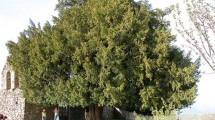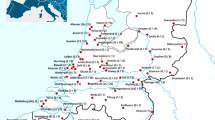Abstract
Our knowledge of the plant diet of the last European hunter-gatherers is hindered by the difficulties of recording poorly durable plant tissues. One exception is the hazelnut fruit, which preserves well at dry archaeological sites, although usually only in a charred state. Here we give the first evidence for the prehistoric (Mesolithic) use of seeds of the Swiss stone pine, specifically for the time period 8239 − 7943 cal bc, when this edible seed-bearing tree was an important element of local boreal forests in northern Bohemia, Czech Republic. This local population of Swiss stone pine became extinct at the end of the Early Holocene without leaving modern offspring in the lowlands and middle elevations of central Europe.







Similar content being viewed by others
References
Beug H-J (2015) Leitfaden der Pollenbestimmung für mitteleuropa und angrenzende Gebiete, 2nd edn. Pfeil, München
Bronk Ramsey C (2009) Bayesian analysis of radiocarbon dates. Radiocarbon 51:337–360
Bussotti F (2002) Pines of Silvicultural Importance. CABI Publishing, Wallingford
Butterworth PJ, Ellis PR, Wollstonecroft M (2016) Why protein is not enough: the roles of plants and plant processing in delivering the dietary requirements of modern and early Homo. In: Hardy K, Kubiak-Martens L (eds) Wild harvest: plants in the hominin and pre-agrarian human worlds. Oxbow Books, Oxford, pp 31–54
Caudullo G, de Rigo D (2016) Pinus cembra in Europe: distribution, habitat, usage and threats. In: San-Miguel-Ayanz J, de Rigo D, Caudullo G, Houston Durant T, Mauri A (eds) European Atlas of Forest Tree Species. Publications Office of the European Union, Luxembourg, pp 120–121
Cordain L, Miller JB, Eaton SB et al (2000) Plant-animal subsistence ratios and macronutrient energy estimations in worldwide hunter-gatherer diets. Am J Clin Nutr 71:682–692
Divišová M, Šída P (2015) Plant use in the mesolithic period. Archaeobotanical data from the Czech Republic in a european context - A review. Interdiscip Archaeol 6:95–106
Engel Z, Nývlt D, Křížek M et al (2010) Sedimentary evidence of landscape and climate history since the end of MIS 3 in the Krkonoše Mountains, Czech Republic. Quat Sci Rev 29:913–927
Erdtman G (1960) The Acetolysis Method - A revised description. Sven Bot Tidskr 54:561–564
Farjon A (2017) Pinus cembra. The IUCN Red List of Threatened Species 2017. https://doi.org/10.2305/IUCN.UK.2017-2.RLTS.T42349A95684563.en. Accessed 4 July 2022
Feurdean A, Tanţău I, Fărcaş S (2011) Holocene variability in the range distribution and abundance of Pinus, Picea abies, and Quercus in Romania; implications for their current status. Quat Sci Rev 30:3,060 – 3,075
Grimm EC (1991) TILIA and TILIA. GRAPH computer programs. Illinois State Museum, Springfield
Hardy BL (2010) Climatic variability and plant food distribution in Pleistocene Europe: implications for neanderthal diet and subsistence. Quat Sci Rev 29:662–679
Hardy K, Kubiak-Martens L (2016) Introduction. In: Hardy K, Kubiak-Martens L (eds) Wild harvest: plants in the hominin and pre-agrarian human worlds. Oxbow Books, Oxford, pp 1–16
Höhn M, Gugerli F, Abran P et al (2009) Variation in the chloroplast DNA of swiss stone pine (Pinus cembra L.) reflects contrasting post-glacial history of populations from the Carpathians and the Alps.J Biogeogr36:1,798-1,806
Holst D (2010) Hazelnut economy of early holocene hunter-gatherers: a case study from Mesolithic Duvensee, northern Germany.J Archaeol Sci37:2,871-2,880
Jacomet S, Vandorpe P (2022) The search for a needle in a haystack–new studies on plant use during the Mesolithic in southwest Central Europe. J Archaeol Sci: Rep 41:103308
Jankovská V (1984) Late glacial finds of Pinus cembra L. in the Lubovnianská kotlina Basin. Folia Geobot Phytotax 19:323–325
Jankovská V, Pokorný P (2008) Forest vegetation of the last full-glacial period in the western Carpathians (Slovakia and Czech Republic). Preslia 80:307–324
Juřičková L, Šída P, Horáčková J, Ložek V, Pokorný P (2020) The lost paradise of snails: Transformation of the middle-holocene forest ecosystems in Bohemia, Czech Republic, as revealed by declining land snail diversity.Holocene30:1,254-1,265
Kubiak-Martens L (1996) Evidence for possible use of plant foods in palaeolithic and mesolithic diet from the site of Całowanie in the central part of the polish Plain. Veget Hist Archaeobot 5:33–38
Kubiak-Martens L (2016) Scanning electron microscopy and starchy food in Mesolithic Europe: the importance of roots and tubers in Mesolithic diet. In: Hardy K, Kubiak-Martens L (eds) Wild harvest: plants in the hominin and pre-agrarian human worlds. Oxbow Books, Oxford, pp 113–134
Lendvay B, Höhn M, Brodbeck S, Mindrescu M, Gugerli F (2014) Genetic structure in Pinus cembra from the Carpathian Mountains inferred from nuclear and chloroplast microsatellites confirms post-glacial range contraction and identifies introduced individuals. Tree Genet Genomes 10:1,419-1,433
Łuczaj Ł, Szymański WM (2007) Wild vascular plants gathered for consumption in the polish countryside: a review. J Ethnobiol Ethnomed 3:17. https://doi.org/10.1186/1746-4269-3-17
Mutke S, Pastor A, Picardo A (2013) Toward a traceability of European pine nuts “from forest to fork”. In: Mutke S, Piqué M, Calama R (eds) Mediterranean stone pine for agroforestry. Options Méditerranéennes: Série A. Séminaires Méditerranéens 105. CIHEAM / FAO / INIA / IRTA / CESEFOR / CTFC, Zaragoza, pp 105–109
Nowaczyk B (2008) Changes in natural environment in the vicinity of Osłonki (Kujawy, central Poland) in the light of geological and geomorphological investigations. Folia Quat 78:7–31
Novák J, Abraham V, Šída P, Pokorný P (2019) Late Holocene forest transformation in sandstone landscapes of the Czech Republic: stand-scale comparison of charcoal and pollen records.Holocene29:1,468-1,479
Petr L, Novák J (2014) High vegetation and environmental diversity during the late glacial and early holocene on the example of lowlands in the Czech Republic. Biologia 69:847–862
Pokorný P, Ptáková M, Šída P (2020) Využívání planých rostlin v lovecko-sběračském období a palynologická indikace lidské přítomnosti ve skalních územích Českého ráje. In: Šída P, Pokorný P (eds) Mezolit severních Čech III. Vývoj pravěké krajiny Českého ráje: Vegetace, fauna, lidé. Dolnověstonické studie 25. Archeologický ústav AV ČR, Brno, pp 90–95
Pokorný P, Bobek P, Šída P et al (2022) Managing wilderness? Holocene-scale, human-related disturbance dynamics as revealed in a remote, forested area in the Czech Republic. Holocene 32:584–596
Prošek F, Ložek V (1953) Mesolitické sídliště v Zátyní u Dubé. Anthropozoikum 2:93–160
Ptáková M, Pokorný P, Šída P et al (2021a) From mesolithic hunters to Iron Age herders: a unique record of woodland use from eastern Central Europe (Czech Republic). Veget Hist Archaeobot 30:269–286
Ptáková M, Šída P, Kovačiková L (2021b) What was on the menu? Mesolithic cooking and consumption practices in inland central Europe based on analysis of fireplaces. Quat Int 586:90–104
Ptáková M, Šída P, Vondrovský V, Pokorný P (2021c) Islands of difference: an ecologically explicit model of central european neolithisation. Environ Archaeol. https://doi.org/10.1080/14614103.2021.1985918
Šída P, Pokorný P (eds) (2020) Mezolit severních Čech III. Vývoj pravěké krajiny Českého ráje: Vegetace, fauna, lidé. Dolnověstonické studie 25. Archeologický ústav AV ČR, Brno
Svoboda JA (ed) (2003) Mezolit severních Čech. Komplexní výzkum skalních převisů na Českolipsku a Děčínsku, 1978–2003. Archeologický ústav AV ČR, Brno. Dolnověstonické studie 9
Svoboda JA (ed) (2017) Mezolit severních Čech II. Komplexní výzkum skalních převisů na Českolipsku a Děčínsku, 2003–2015. Archeologický ústav AV ČR, Brno. Dolnověstonické studie 22
Svoboda JA, Hajnalová M, Horáček I et al (2007) Mesolithic settlement and activities in rockshelters of the Kamenice river canyon, Czech Republic. Eurasian Prehist 5:95–127
Svoboda J, Pokorný P, Horáček I et al (2018) Late glacial and holocene sequences in rockshelters and adjacent wetlands of Northern Bohemia, Czech Republic: correlation of environmental and archaeological records. Quat Int 465:234–250
Zoller H (1991) Pinus. In: Conert HJ, Hamann U, Schultze-Motel W, Wagenitz G (eds) Gustav Hegi-Illustrierte Flora von Mitteleuropa. Blackwell, Berlin, pp 77–83
Acknowledgements
This work was supported by OP RDE, MEYS, under the project “Ultra-trace isotope research in social and environmental studies using accelerator mass spectrometry”, Reg. No. CZ.02.1.01/0.0/0.0/16_019/0000728. The work of Petr Šída was supported by the specific research project “On the way from the last hunters to the first shepherds” (2021) of the Philosophical Faculty of the University of Hradec Králové. Part of the primary data was obtained thanks to the project of the National Agency for Agricultural Research QK21010335 (LARIXUTOR). We thank Steve Ridgill for the language correction.
Author information
Authors and Affiliations
Corresponding author
Additional information
Communicated by C.C. Bakels.
Publisher’s Note
Springer Nature remains neutral with regard to jurisdictional claims in published maps and institutional affiliations.
Rights and permissions
Springer Nature or its licensor (e.g. a society or other partner) holds exclusive rights to this article under a publishing agreement with the author(s) or other rightsholder(s); author self-archiving of the accepted manuscript version of this article is solely governed by the terms of such publishing agreement and applicable law.
About this article
Cite this article
Pokorný, P., Šída, P., Ptáková, M. et al. A little luxury doesn’t hurt: Swiss stone pine (Pinus cembra L.) - an unexpected item in the diet of central European Mesolithic hunter-gatherers. Veget Hist Archaeobot 32, 253–262 (2023). https://doi.org/10.1007/s00334-022-00901-1
Received:
Accepted:
Published:
Issue Date:
DOI: https://doi.org/10.1007/s00334-022-00901-1




